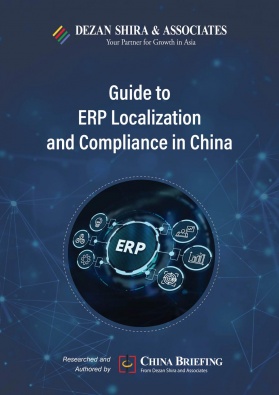China’s Third Plenum – Key Takeaways for Foreign Investors
The Third Plenary Session of the CCP Central Committee adopted a broad range of reform measures to be implemented over the next five years. The measures cover everything from the economy to fiscal policy to social programs and have the potential to reform the country’s business and investment environment. We cover the key policy proposals adopted during China’s Third Plenum and discuss the potential impact on foreign investors and businesses.
On July 18, on the final day of the third plenary session of the 20th Chinese Communist Party (CCP) Central Committee, the government adopted the Decision of The CPC Central Committee on Further Deepening Reform and Promoting Chinese-Style Modernization (the “Decision”. This extensive 60-point document has been widely anticipated by investors, companies, and other stakeholders for its potential to introduce substantial reforms to the country’s economic, fiscal, and social system over the next five years.
The Decision passed during China’s Third Plenum has not disappointed, proposing a staggering 300 reform measures to be completed by 2029, which marks the 80th anniversary of the founding of the People’s Republic of China.
While the breadth of reforms proposed in the Decision is monumental, most of the measures are modest in scope, providing a pathway for steady and controlled development over the next five years, rather than drastic change. The reform measures also largely keep the country on the same development trajectory that the government has developed in the years since the pandemic, with a focus on prudent fiscal and monetary policy, gradual market opening, the strengthening of supply chains, and bolstering science and technology innovation, among others.
Companies, investors, and other stakeholders should pay close attention to the measures proposed for their respective fields and industries, as they provide a blueprint for the development trajectory of various aspects of the economic and regulatory environment.
How will China reform its economy to boost growth?
On economic development, the Decision outlines two major goals: building a high-level socialist market economic system and improving institutional mechanisms to promote high-quality economic development
Building a high-level socialist market economic system will involve measures such as ensuring an equal footing for private and public enterprises by reforming state-owned companies and assets, improving the business environment for private companies, standardizing and unifying rules and regulations across the country, and strengthening legal rights and market access for companies.
Meanwhile, measures related to high-quality economic development focus on advancing modern and digital industries, as well as modernizing and digitizing traditional industries. This will include promoting “new-quality productivity” (新质生产力), moving production and manufacturing up the value chain, accelerating “new-type industrialization”, developing the modern services industry, and improving supply chain resilience.
Improving the business environment and boosting the private economy
An important component of the Decision’s economic policy proposals is the measures to boost the private economy. While public companies have rapidly rebounded since the pandemic, private sector recovery has been slow, with private companies falling behind in metrics such as investment and value-added output. As private companies account for around 60 percent of the country’s GDP and 80 percent of urban employment, improving their performance will be paramount to securing long-term growth.
Among reform measures stipulated in the Decision is a proposal to “formulate a law to promote the private economy”. In February 2024, the Ministry of Justice (MOJ) announced that it had already begun to draft a law to boost the private sector, which will seek to “implement concrete measures within the legal system to ensure equal treatment of state-owned and private enterprises.” It will also address core concerns of private companies, including the legal protection of property rights and the rights of entrepreneurs, fair participation in market competition, equal access to production resources, fair law enforcement, impartial judicial processes, and addressing the issue of overdue payments to small and medium-sized enterprises (SMEs).
Meanwhile, the Decision also proposes a range of tasks to improve the business environment, many of which overlap with the stated aims of the draft law. These include (but are not limited to):
- Breaking down market access barriers;
- Promoting fair opening of competitive areas of infrastructure to business entities;
- Improving the long-term mechanism for private enterprises to participate in the construction of major national projects;
- Improving the policy system for supporting private enterprise financing and solving the problem of difficult and expensive financing; and
- Improving the legal and regulatory system for long-term supervision of fees related to enterprises and the settlement of overdue accounts owed to enterprises.
These reform measures largely build upon previous efforts to boost the private economy. Over the last year, the government has released a series of policy documents aimed at improving the business environment. A set of measures to boost the private economy released in July 2023 outlined 17 measures for boosting private investment, including identifying and promoting key projects for private investment, providing the necessary financial and resource support, and fostering a healthy and transparent environment for private investors. That said, listing these reforms in the Decision indicates that both the state and local governments will commit significant time and resources toward these goals over the next five years.
Building the national unified market
The Decision proposes several measures to build the national unified market by unifying market foundation rules, ensuring fair regulation, and establishing high-standard connectivity of market infrastructure.
The national unified market is an initiative to standardize and unify the implementation of regulations across various industries in China. First proposed in the 14th Five-Year Plan, it seeks to eliminate local protectionism, industry monopolies, and market segmentation by aligning standards, rules, and policies across regions and industries. It also intends to facilitate the smooth flow of production resources and create a market environment that is efficient, standardized, open, and conducive to fair competition.
The Decision aims to develop the national unified market by unifying market foundation rules and ensuring fair and consistent regulation across regions and industries. It proposes strengthening measures to combat monopolies and unfair competition, eliminate regulations that create market segmentation and prohibit illegal preferential policies by standardizing local investment promotion regulations.
Additionally, the Decision seeks to improve the mechanism for determining resource prices primarily based on market supply and demand, preventing improper government interference in price formation. It also proposes establishing a system where labor, capital, land, knowledge, technology, management, and data are compensated according to their market-evaluated contributions.
Which tax reform measures have been proposed?
The proposed tax reforms aim to enhance the tax system to support high-quality development, ensure social equity, and unify the market. The reforms focus mainly on three key areas: tax policies for businesses, tax policies for individuals, and policies to support local governments and alleviate their debt.
The Decision seeks to improve the tax system to accommodate new business forms and optimize the tax structure for businesses. It aims to fully implement statutory taxation principles and standardize tax preferential policies. The reforms include improving the direct tax system and refining tax policies related to business income, capital income, and property income. Additionally, it emphasizes deepening tax collection and management reforms to enhance efficiency and fairness in tax administration.
For individuals, the Decision proposes enhancements to the individual income tax system. It plans to improve the system by combining comprehensive and classified taxation approaches. The reforms include standardizing tax policies on various income types, such as business income, capital income, and property income while implementing a unified taxation system for labor income. These changes aim to simplify the tax system and ensure equitable taxation across different income sources.
To support local governments and reduce debt, the Decision promotes the backward shift of consumption tax collection to local governments, enhances the VAT refund policy and deduction chain, and optimizes the sharing ratio of shared taxes. It suggests merging certain local surcharges into a unified local surcharge system and authorizing local governments to set specific tax rates within a defined range. Furthermore, it plans to expand the scope of support for local government special bonds and improve the management of government debt by establishing a comprehensive debt monitoring and supervision system. The reforms also aim to standardize non-tax revenue management and transfer some management authority to local governments to tailor approaches based on local conditions.
How will China promote foreign trade and investment?
The Decision seeks to integrate trade policies with fiscal, financial, and industrial policies to further strengthen China’s position as a trade powerhouse. This indicates China’s continuous commitment to globalization and its determination to further liberalize its trade and investment regime. Innovations in customs, taxation, and foreign exchange regulations are encouraged to foster a conducive environment for new business forms.
Additionally, it calls for accelerating the development of digital trade and the construction of comprehensive cross-border e-commerce zones, as well as prioritizing the establishment of commodity trading centers and global distribution hubs. Improving the trade risk control mechanism, export control system, and trade remedy measures are also emphasized.
Meanwhile, the Decision also proposes a range of measures to enhance foreign investment and overseas investment management. Key measures include expanding the catalog of encouraged industries for foreign investment reducing the negative list for foreign investment, as well as “completely removing” restrictions on foreign investment in manufacturing. It also encourages further market opening in sectors from which foreign investors have previously been limited, such as telecommunications, the internet, education, culture, and healthcare.
Other measures include reforms to ensure that foreign companies receive national treatment in access to resources, qualifications, standards, and government procurement, as well as mechanisms to facilitate entry, residence, healthcare, and payment for foreign personnel.
Finally, the Decision also aims to advance China’s Belt and Road Initiative (BRI) with a range of proposals, including continuing to implement the BRI Science and Technology Innovation Action Plan and strengthening cooperation in the fields of green development, the digital economy, artificial intelligence, energy, taxation, finance, disaster reduction, and so on.
How will China strengthen its science and technology capabilities?
The Decision aims to deepen the reform of the science and technology system by focusing on key strategic areas and optimizing the organizational mechanisms for scientific and technological innovation. It emphasizes aligning with global technological frontiers, the main economic battlegrounds, national priorities, and public health needs. The approach includes strengthening national strategic scientific and technological capabilities, enhancing the national laboratory system, and optimizing the roles and layouts of research institutions, universities, and leading tech enterprises. It promotes collaboration between central and local levels and various innovation platforms while encouraging new R&D institutions and leveraging China’s large market to better coordinate innovation resources.
In terms of R&D, the Decision aims to improve the management of scientific plans, strengthen basic and frontier research, and increase the proportion of funding dedicated to basic research. It encourages a mix of competitive and stable funding and supports high-risk, high-value research projects. The reform of the science and technology evaluation system will be deepened, with a focus on scientific ethics and academic integrity.
Companies will also be supported in leading or participating in national research tasks, and the Decision proposes mechanisms to support the growth of specialized, innovative SMEs. This includes policies to encourage SMEs to increase R&D investment and improve the system for licensing research achievements to them.
Lastly, a compatible financial system will be built to support scientific and technological innovation, with enhanced financial support for major national projects and tech-based SMEs. Policies will be improved to support long-term capital investments in early-stage and hard technologies, establish a science and technology insurance system, and facilitate foreign equity and venture capital investments in China.
Measures to cultivate science and technology talent
In addition to measures to boost science and technology innovation, the Decision aims to deepen the reform of talent development systems and mechanisms by implementing more active, open, and effective talent policies. It seeks to improve the mechanisms for independent talent training and accelerate the establishment of a national high-level talent base and platforms for attracting and gathering talent.
A key focus is on building national strategic talent forces, emphasizing the cultivation and training of strategic scientists, first-class scientific and technological leaders, innovation teams, outstanding engineers, and high-skilled workers. The Decision aims to enhance the quality of all types of talents and build a first-class team of industrial technical workers. It also seeks to improve the mechanisms for the orderly flow of talent, promoting more even regional distribution and deepening talent cooperation across different regions.
Efforts will be made to enhance the mechanisms for discovering, selecting, and training young innovative talents, with better guarantees for the treatment of young scientific and technological personnel. The system will be improved to ensure that scientific researchers can focus on their work.
To strengthen the talent incentive mechanism, the Decision proposes establishing a talent evaluation system guided by innovation ability, quality, effectiveness, and contribution, and opening up talent exchange channels between universities, research institutes, and enterprises. Additionally, it will improve the support and guarantee mechanism for introducing overseas talent and form a talent system with international competitiveness. The Decision also explores the establishment of a “high-tech talent immigration system”, hinting at potential visa schemes for science and technology workers.
How will China address the demographic decline and aging population?
Among the various proposals to reform social welfare and support policies are measures aimed at boosting birthrates and supporting the aging population. China’s population fell by 2.08 million people in 2023, marking the second consecutive year of population decline.
China’s rapidly declining birth rates and aging population will have long-lasting effects on the country’s economy. The government has already taken steps to address these issues, such as extending maternity and childcare leave and launching a private pension system.
The Decision seeks to establish a “comprehensive support and service system for population development” in order to address demographic issues. This will include improving the birth support policy system and incentive mechanisms, improving the maternity leave system, and establishing a “birth subsidy system”. Measures will be introduced to reduce the costs of childbirth, child-rearing, and education. It also proposes to increase deductions of individual income tax.
The Decision also calls for improving policies and mechanisms to develop the elderly care sector and industry. Among the measures proposed, it vows to gradually raise the statutory retirement age “based on the principles of voluntariness and flexibility”. The current statutory retirement age is 60 for men, 55 for women in management positions, and 50 for women in manufacturing positions. The Chinese government has long signaled that it will raise the retirement age, and while it has not proposed a specific age, it is widely believed that it will be raised to 65 for both men and women.
As the measures proposed in the Decision are to be completed by 2029, businesses can expect to see a gradual change in the statutory retirement age over the next five years. This will have a significant impact on companies’ labor relations and HR policies and could possibly impact hiring and remuneration considerations.
Key takeaways for foreign investors
The Decision offers key insights for foreign investors, particularly regarding tax reforms, policy incentives in priority industries, market access, and other significant policy directions.
Foreign investors should note the potential for tax reforms aimed at standardizing tax policies and improving the efficiency of tax administration. This could result in a more predictable and streamlined tax environment for foreign businesses operating in China.
The Decision also signals possible policy incentives in priority industries such as modern and digital industries, integrated circuits, industrial machinery, and advanced materials. For foreign investors, this focus on high-tech and strategic industries may present new opportunities for collaboration and investment.
There is an emphasis on strengthening supply chains and ensuring self-reliance in key sectors, which may involve increased support and resources for domestic industries. While this focus on self-reliance might seem inward-looking, it also highlights areas where foreign expertise and investment could be sought, particularly in enhancing local capabilities and technological advancements.
However, it’s important to recognize that many proposed policy measures are not entirely new. Previous efforts to improve the business environment and ensure an even playing field for public and private companies have not always led to substantial change. The effectiveness of these new measures remains to be seen, and foreign investors should approach them with cautious optimism. While the reforms offer a structured pathway for gradual development, the tangible impact on the business environment will depend on implementation and enforcement.
About Us
China Briefing is one of five regional Asia Briefing publications, supported by Dezan Shira & Associates. For a complimentary subscription to China Briefing’s content products, please click here.
Dezan Shira & Associates assists foreign investors into China and has done so since 1992 through offices in Beijing, Tianjin, Dalian, Qingdao, Shanghai, Hangzhou, Ningbo, Suzhou, Guangzhou, Dongguan, Haikou, Zhongshan, Shenzhen, and Hong Kong. We also have offices in Vietnam, Indonesia, Singapore, United States, Germany, Italy, India, and Dubai (UAE) and partner firms assisting foreign investors in The Philippines, Malaysia, Thailand, Bangladesh, and Australia. For assistance in China, please contact the firm at china@dezshira.com or visit our website at www.dezshira.com.
- Previous Article China’s Futuristic Industries: Investment Prospects in the Emerging Low-Altitude Economy
- Next Article China Announces Several Measures to Facilitate Hotel Accommodation for Overseas Personnel









